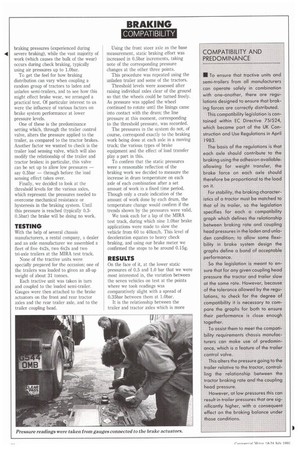COMPATIBILITY AND PREDOMINANCE
Page 32

If you've noticed an error in this article please click here to report it so we can fix it.
• To ensure that tractive units and semi-trailers from all manufacturers can operate safely in combination with one-another, there are regulations designed to ensure that braking forces are correctly distributed.
This compatibility legislation is contained within EC Directive 75/524, which became part of the UK Construction and Use Regulations in April 1983.
The basis of the regulations is that each axle should contribute to the braking using the adhesion available: allowing for weight transfer, the brake force on each axle should therefore be proportional to the load on it.
For stability, the braking characteristics of a tractor must be matched to that of its trailer, so the legislation specifies for each a compatibility graph which defines the relationship between braking rote and coupling head pressures in the laden and unladen condition; to allow some flexibility in brake system design the graphs define a band of acceptable performance.
So the legislation is meant to ensure that for any given coupling head pressure the tractor and trailer slow at the same rate. However, because of the tolerance allowed by the regulations, to check for the degree of compatibility it is necessary to compare the graphs for both to ensure their performance is close enough together.
To assist them to meet the compatibility requirements chassis manufacturers can make use of predominance, which is a feature of the trailer control valve.
This alters the pressure going to the trailer relative to the tractor, controlling the relationship between the tractor braking rate and the coupling head pressure.
However, at low pressures this can result in trailer pressures that are significantly higher, with a consequent effect on the braking balance under those conditions.












































































































